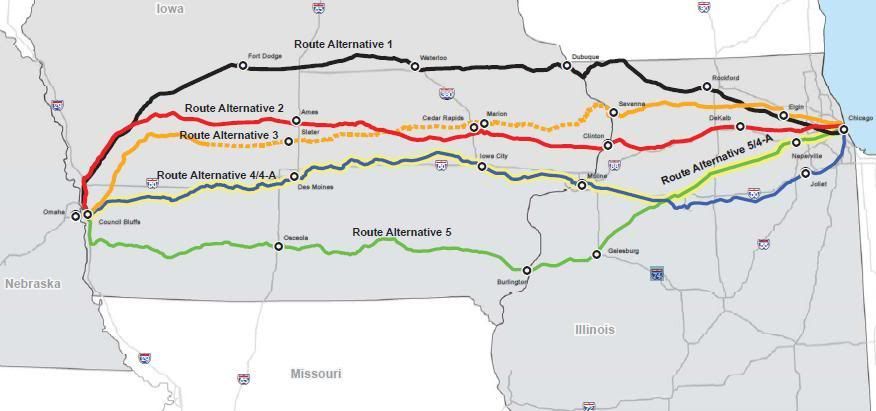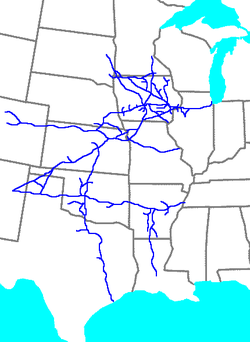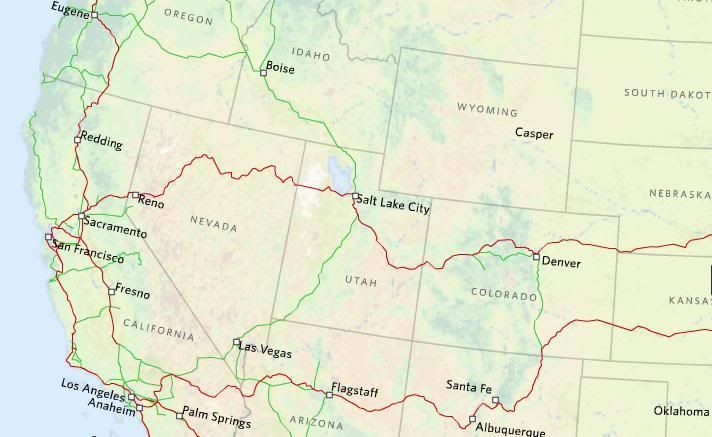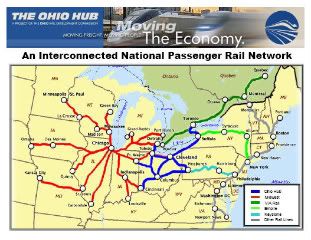(4 pm. – promoted by ek hornbeck)
Burning the Midnight Oil for Living Energy Independence
 The Iowa Department of Transport has just completed the Chicago to Omaha Regional Passenger Rail System Planning Study, to select its preferred alignment for a detailed Environmental Impact Report.
The Iowa Department of Transport has just completed the Chicago to Omaha Regional Passenger Rail System Planning Study, to select its preferred alignment for a detailed Environmental Impact Report.
There were five alignments in the study, based on the five historical passenger rail services between Chicago and Omaha. From north to south, these are: the Illinois Central; the Chicago & Northwestern; the Milwaukee Road; the Rock Island Line; and the Burlington Line. The study also included one combined alignment, based on where the Burlington Line and the Rock Island Line cross in Wyanet in western Illinois.
The combined alignment is the one selected, taking the Burlington alignment out of Chicago, and then taking the Rock Island line to Moline in the Quad Cities on the Illinois / Iowa border and through Iowa City and Des Moines to Omaha (probably via Council Bluffs, but that has yet to be determined).
Online Forum Now Open
There is an Online Open House. Any Iowans who were not able to get to the live open house sessions this past week can go to that link and get an online briefing, presented with video clips, information on the web page, and links through to additional resources.
Additional resources are at the Iowa Department of Transport online site, including flyers and fact sheets that citizen advocates are free to print up and pass around.
The Advantages of the Rock Island Line

The fastest alignment is the Cedar Rapids route (red line), the Chicago and Northwestern line through Dekalb, Cedar Rapids, and Ames. Excluding the Chicago and Omaha metro areas common to all routes, this route has an intermediate service population of 524,000. This alternative would require new third main track the entire distance, and a new Mississippi River bridge.
The cheapest alignment would be the Burlington line all the way to Omaha (green line). That is the route that the California Zephyr presently takes, running through Galesburg, Burlington, and Osceola, for an intermediate service population of 167,000. Upgrading capacity to allow five (5) Rapid Passenger Rail services per day or more requires a third main rail, with space in the existing corridor except a stretch along the Mississippi River, and a new Mississippi River Bridge. This alignment would be about 18 minutes slower than the Cedar Rapids route at 79mph, and 13 minutes slower at 110mph.
The Rock Island Line (blue line) through Moline, Iowa City, and Des Moines serves the greatest intermediate population, with an intermediate service population of 1,034,000. This alternative is expected to be able to use the existing Mississippi River bridge between Rock Island, Illinois and Davenport, Iowa, and would require new second main track for half of its length, and new third track for a tenth of its length. It would be 17 minutes slower than the Cedar Rapids route at 79mph, and 25 minutes slower at 110mph.
The Milwaukee Road alignment was filtered out at the first stage of route selection, as much of its right of way was abandoned, and so it would require the most extensive works for the purpose. The Illinois Central line was carried forward to the second stage, but preliminary travel time analysis showed it to be slower than automobile and commercial bus service at 79mph and 90mph, and so it does not meet a main criterion of the study.
Piecing Together a Winning Combination
While the Rock Island line has the wildcard advantage of the best song of the five route alternates, it does have a glaring weakness: while the Cedar Rapid route and the Burlington route both connect directly to Chicago Union Station, the Rock Island Line terminates at La Salle Street station, several blocks from Union Station. Making a junction to track with a direct connection to Chicago Union Station would require additional work, and would have to be fitted into the CREATE plan to remove passenger and freight rail bottlenecks in the greater Chicago area.
However, the Burlington Line and Rock Island Line cross in western Illinois, and it turns out that the route formed from the Burlington line on the eastern side to Chicago and the Rock Island Line on the western side through Iowa to Omaha (yellow highlight along green and blue lines) is first or second on most things we would want from a route.
The combined Rock Island Line / Burlington Line route has the same intermediate population as the Rock Island Line, so it is equal first in intermediate population. It is the second fastest route, 4 minutes slower than the Cedar Rapids route at 79mph and 14 minutes slower at 110mph. It is the second lowest cost alternative, after the Burlington line. And with its direct connection of the Burlington line into Chicago’s Union Station and superior speed to the Rock Island line all the way, it has the highest projected ridership and revenue.
Now, this is an Iowa Department of Transport study, and the preferred alignment includes the old main Rock Island corridor through Iowa, picking up freight at Omaha from Union Pacific and heading on through to Denver to pick up freight from . And its the rail corridor that actually goes take the Mississippi River bridge between Rock Island, Illinois, and Davenport, Iowa. So I’m going to go ahead and call it the Rock Island alignment, and claim the song. But as far as the train, the Rock Island tradition was to call their fastest passenger trains “Rockets”, and this train would be, in effect, the New Cornhusker Rocket.
 To be clear, however, the Rock Island Line itself ~ the Chicago, Rock Island and Pacific Railways ~ is long gone, having been, according to the Wikipedia machine, “one railroad too many” between Chicago and the Omaha terminus of the Union Pacific, and the specific corridor in question is primarily owned by the Iowa Interstate Railway. During an unsuccessful merger with the Union Pacific that dragged on for over a decade, the Rock allowed its track and rolling stock to run down. By the time that the merger was approved in the 70’s, it was no longer the appealing merger prospect for Union Pacific that it had been in the 50’s, and UP decline to proceed with the merger. After struggling to survive, the Rock was finally ordered liquidated in the early 1980’s, with Union Pacific ending up with more of the railroad than it would have done under the terms of the approved merger … but not with the star of today’s show, the actual Rock Island Line from Chicago to Omaha over the Mississippi River bridge between Rock Island Illinois and Davenport, Iowa.
To be clear, however, the Rock Island Line itself ~ the Chicago, Rock Island and Pacific Railways ~ is long gone, having been, according to the Wikipedia machine, “one railroad too many” between Chicago and the Omaha terminus of the Union Pacific, and the specific corridor in question is primarily owned by the Iowa Interstate Railway. During an unsuccessful merger with the Union Pacific that dragged on for over a decade, the Rock allowed its track and rolling stock to run down. By the time that the merger was approved in the 70’s, it was no longer the appealing merger prospect for Union Pacific that it had been in the 50’s, and UP decline to proceed with the merger. After struggling to survive, the Rock was finally ordered liquidated in the early 1980’s, with Union Pacific ending up with more of the railroad than it would have done under the terms of the approved merger … but not with the star of today’s show, the actual Rock Island Line from Chicago to Omaha over the Mississippi River bridge between Rock Island Illinois and Davenport, Iowa.
Wait a Minute, Didn’t They Already Fund This Work?
Now, for someone who has been following Midwestern HSR, there is a lot of deja vu to this news, since the news back in October 2010 was:
The major success for the Midwest in the Obama administration’s second round of rail funding was a $230 million federal grant to Iowa and Illinois to establish the new Amtrak service between Chicago and Iowa City, with travel times of less than five hours projected end to end. The train would also stop in Moline.
The line is scheduled for completion in 2015, assuming a steady continuation of funding, officials said.
Two daily round trips are planned for the Chicago-Quad Cities-Iowa City route. Initial top speeds will be 79 mph, which is Amtrak’s current limit. Longer-term plans call for additional daily round trips and increasing speeds to 90 mph and perhaps to 110 mph, officials said.
The plan hit a roadblock in Iowa when Governor Bransted balked at the $3m in operating subsidy that would be required for the initial service to Iowa City. As described by demoisnedem at Bleeding Heartland in September of last year:
During this year’s legislative session, Republican lawmakers balked at allocating matching funds to support the Chicago to Iowa City rail project. Some Republicans objected to the principle of subsidizing passenger rail service, period. Since the plan didn’t extend west of Iowa City and involved maximum train speeds of 79 miles per hour, the potential benefits were limited to a relatively small percentage of Iowans.
Funding for passenger rail was one of the last budget disagreements House Republicans and Senate Democrats resolved before the session ended. The final deal left state matching funds for the project hanging by a thread.
Iowa DOT officials are now looking at a plan that would support higher-speed trains and serve a larger population. Funding for a $2 million study has already been allocated by the Federal Railroad Administration and the Iowa legislature.
This selection of the preferred route alternative is part of that planning.
In the end, Iowa and Illinois applied to have the Federal funding separated, and Illinois came through with its matching funds commitment, so the funding of the Chicago to the Quad Cities portion of the line was announced on 12 December, 2011:
U.S. Transportation Secretary Ray LaHood on Dec. 12 announced more than $177 million for the Illinois Department of Transportation (IDOT) for a passenger rail project that will operate twice-daily round-trip service between Chicago and the Quad Cities and put nearly 2,000 Americans back to work this spring.
“With America’s population set to grow by 100 million over the next 40 years, passenger rail will play a vital role in meeting America’s long-term transportation challenges,” LaHood said in a written statement. “This project, and the others like it, will reduce congestion for the region, create jobs and make the Midwest a better place to start a business.”
The start of twice-daily round-trip service between Chicago and the Quad Cities, with intermediate stops at Geneseo, Princeton, Mendota, and Plano, Ill., will be made possible by infrastructure improvements including, a new station at Geneseo, a layover facility in the Quad Cities area, communication and signaling improvements and the purchase of new passenger rail equipment.
So preliminary work on the Illinois section of this route is already underway. The alternatives analysis started as if from a clean sheet, and seem to have included all credible alignments set forward ~ but the serious options were to extend the Rockford route through to Iowa, extend the Quad Cities route through to Iowa, and upgrade the current Amtrak long-distance route through Iowa. And between those three, extending the Quad Cities route is clearly the strongest option.
Especially important is the revenue potential of the Quad Cities / Iowa City / Des Moines / Omaha route. With a state legislature that balked at a rail operating subsidy, ridership potential is important in two ways. First, no-subsidy systems have a higher capital cost, to offer the trip speed and service frequencies that attract break-even ridership. The stronger the ridership potential, the lower the capital cost required to hit break-even ridership. And, second, the greater the potential ridership, the more Iowans who can imagine taking the train, and the more local businesses who can imagine a direct benefit from having the service available. That makes for a better chance to swing the political support that the system requires.
What comes next is the Environmental Impact Report (EIR). Its in the EIR that the alternatives of 79mph operation, 90mph operation and 110mph operation will be examined in detail. Having the EIR completed is the critical step in having a plan on the shelf ready to apply for Federal funding.
The New Cornhusker Rocket and Our Emerging Intercity Rail Network
If we are reversing the rollback of Rapid Passenger Rail service ~ and taking trips speeds up a notch to take advantage of technological progress elsewhere in the world since World War II ~ then in the decline of the Rock Island, the Denver Rocket became the Cornhusker Rocket, which became the Rock City Rocket. Then, as the Rock Island declined and the Rock City Rocket declined from a 2 hr 15 minute service in the 50’s to a 4+ hour service in the 70’s, ridership declined until the State of Illinois declined to continue subsidizing the service and it was shut down.
 Now that the State of Illinois is restoring Quad City service, then if the service is upgraded to 90mph or 110mph and extended to Omaha, the next obvious step from Omaha is Denver. However, as discussed previously in the Sunday Train, the compelling Rapid Rail alignment through Denver is North/South along the Front Range. Barring investment in a Rapid Freight Rail alignment through the Rockies (as is proposed in the Steel Interstate National Line), service beyond Denver would be by an Amtrak sleeper train.
Now that the State of Illinois is restoring Quad City service, then if the service is upgraded to 90mph or 110mph and extended to Omaha, the next obvious step from Omaha is Denver. However, as discussed previously in the Sunday Train, the compelling Rapid Rail alignment through Denver is North/South along the Front Range. Barring investment in a Rapid Freight Rail alignment through the Rockies (as is proposed in the Steel Interstate National Line), service beyond Denver would be by an Amtrak sleeper train.
As far as long-distance Amtrak routes, the California Zephyr only benefits from the Burlington Line portion of the work on the Quad Cities line. However, if the Quad Cities line is upgraded to at least 90mph, and a 79mph or faster passenger rail corridor is available from the Quad Cities through to Omaha, the California Zephyr would be likely to shift its alignment to the shorter, faster route serving larger population centers.
So as soon as the Quad Cities to Omaha line is completed, the line is likely to offer daily service to Denver, Salt Lake City, and points west, via the already existing Chicago / Oakland service. While this is not time-competitive with driving by any means, the current service leaves Omaha at 11pm and arrives in Denver a bit after 7am, so you can sleep on the way, which is dangerous to attempt while driving and tends to result in trip times that are themselves uncompetitive with train travel.
To the east, the immediate benefit of connections at Chicago Union Station is access to connecting services through Greater Chicago and to much of Illinois.
Multiple connections per day to Chicago also gives access to Amtrak corridor service to Milwaukee and Detroit, as well as Amtrak sleeper services to New Orleans, to Boston and New York via Cleveland; to New York and Washington via Cleveland and Pittsburgh; and to Indianapolis, Cincinnati and West Virginia, more or less, via the Cardinal. Upgrades to the Detroit service are already underway, as are improvements in New York State along the Lakeshore route to NYC and Boston.
 However, with the current skeleton Amtrak system, someone who does not have a couple of days to kill would likely be flying if they are going as far as the east coast. Its with the full Midwest Hub Rapid Rail system (red lines in the map) that connections to interstate services to Chicago Union Station really gain leverage, with trips faster than driving opening up throughout the Great Lakes states.
However, with the current skeleton Amtrak system, someone who does not have a couple of days to kill would likely be flying if they are going as far as the east coast. Its with the full Midwest Hub Rapid Rail system (red lines in the map) that connections to interstate services to Chicago Union Station really gain leverage, with trips faster than driving opening up throughout the Great Lakes states.
Of course, the same is true in the opposite direction. Given the present state of the intercity rail network, O’Hare and Midway are as likely to yield inbound Cornhusker Rocket passengers as the intercity rail network outside of Illinois. However, the Midwest Hub opens the option to skip a long road trip and arrive both more quickly and better rested.
Conclusions
Well, you’ve probably guessed by now that I like the route alternative picked by the Iowa DOT, but as always the Conclusion section of the Sunday Train is not the final word, but opening the floor up for discussion. So, waddya think?
Also, as always, its on-topic in the Sunday Train to launch a new comment thread on any topic in sustainable transport.
Midnight Oil ~ Blue Sky Mining

1 comments
Author
… can be more pleasant sitting in a good seat using the WiFi.